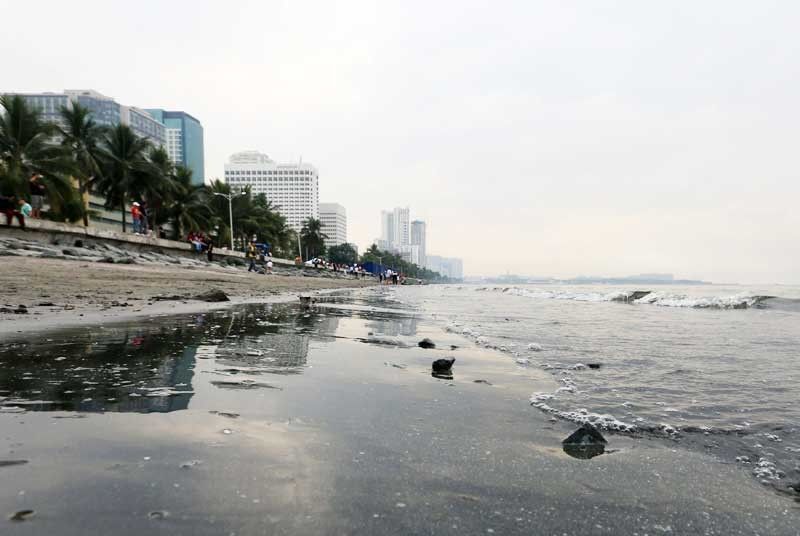Manila Bay: Reclamation vs rehabilitation

Special Report (Part 2)
MANILA, Philippines — When the Duterte administration announced the bold move that it would rehabilitate Manila Bay, environmental groups immediately hitched a ride on the issue.
It was a big and interesting issue that consistently made headlines. The different environmental groups made sure they, too, would be in the spotlight.
Thus, they reiterated their calls to protect the environment.
Reclamation, they said, could cause massive flooding, liquefaction and tsunamis among others.
Massive flooding occurs when excessive water fills normally dry areas along with flowing creeks and rivers, causing a rapid rise of water in a short amount of time. This can happen with little or no warning.
Liquefaction
In industry parlance, soil liquefaction happens when a saturated or partially saturated soil weakens in response to an applied stress.
Tsunamis, meanwhile, are giant waves caused by a displacement of large volume of water.
When an earthquake occurred on Dec. 26, 2004 in the Indian Ocean, it caused a series of tsunamis that killed more than 200,000 people in at least 13 countries.
Among those affected was Marine Beach in Chennai, India. It was hit by a tsunami and experts noted that houses had been built right up to the edge of the coast, some on reclaimed land.
These and other negatives effects are the arguments cited by environmental groups.
Thus, environmental groups said that for Manila Bay’s reclamation to succeed, the different reclamation projects should not proceed.
The Climate Reality Project, for instance, said reclamation projects in Manila Bay may threaten the remaining biodiversity in the bay.
Its country manager Rodne Galicha said in a radio interview that the government should focus first on rehabilitating Manila Bay before proceeding with the reclamation.
Galicha said the people have the right to a clean and healthful ecology.
Lawmakers, too
During a recent hearing at the House of Representatives, lawmakers also raised a howl over the many reclamation projects in the country, citing environmental issues.
“We received a lot of concerns from the environmentalist groups. They’re concerned the development of the projects will pose a lot of environmental risks especially on the issue of liquefaction.”
But for the PRA, reclamation and the rehabilitation of Manila Bay can go together.
It said other countries have embarked on reclamation projects as a structurally sound solution to protect their coastlines in light of recent climate change phenomena.
The PRA also said that the alleged negative consequences such as environmental degradation, flooding, land subsidence, etc. have not been established as being a direct consequence of reclamation projects.
“In this regard, the PRA’s thrusts are geared toward promoting ‘purposive’ and ‘protective’ reclamations. Purposive reclamations refer to Legacy Islands on Water (LIoW); islands that are liveable, resilient, safe, sustainable, green, generative, pro-people, future-proofed and innovative and a smart community.
“Protective reclamations, on the other hand, refer to an integrated coastal defense development based on the experience and best practices of renowned water experts such as the Netherlands, Denmark, Belgium and Singapore.
“Already, PRA has completed a Coastal Defense Master Plan for Tacloban and Palo, Leyte, in partnership with the Dutch government. PRA will soon embark on replicating similar studies in other vulnerable coastlines of the Philippine archipelago,” the PRA said.
Furthermore, the PRA explained that land subsidence is caused by over extraction of ground water.
“Over extraction of ground water, in turn, is a consequence of heavy pressures exerted on urban communities by increasing population and increased economic activities such as basement excavations of large buildings,” the PRA said.
The PRA is not aware of any study that directly correlates land subsidence in Metro Manila with the reclamation projects in Manila Bay.
At any rate, the PRA said, reclamation requires project proponents to prepare and submit ‘flooding and flushing studies’ by hydrology experts as part of the agency’s pre-construction and detailed engineering studies before approving any reclamation project.
“The PRA requires the engineering design of the reclamation to provide for adequate channels, drainage and runoff discharge to the open sea, as well as non-blockage of river outfalls and other flood paths,” it also said.
On the issue of storm surges, the PRA said if the reclaimed areas are designed and built higher than the highest recorded waves in Manila Bay (and these are done through sophisticated modelling methods by local and international engineering experts), they will serve as effective barriers and protection of the inland from coastal flooding.
This, the PRA said, was highlighted during the August 2012 Habagat where waves breached the seawall along the open portion of the stretch of Roxas Boulevard from the Manila Yacht Club down to T.M. Kalaw and the area experienced flooding from the surge.
On the other hand, the PRA said, the areas from the Cultural Center of the Philippines all the way up to the Coastal Road in Las Piñas did not suffer severe flooding since the reclaimed areas with their seawalls and wave deflectors effectively blocked the waves.
In all, the PRA said the Environmental Impact Assessment process addresses the effects of reclamation projects on the environment.
“An external review committee, separate from the Environmental Management Bureau of the Department of Environment and Natural Resources and composed of experts in various fields, reviews and evaluates the Environmental Impact studies prepared by reclamation proponents,” the PRA said.
The Environmental Clearance Certificate to be issued by the DENR is also part of the mandatory documents that must be submitted to PRA so that it can evaluate the reclamation project proposal and recommend its approval, the PRA added.
- Latest
- Trending






























